Currency
 Quotable:
Quotable:
“There are two trains running in East Asia, each fueled by hollow rhetoric and propelled by dangerous, self-deluding myths. Each of these locomotives heeds only its own signal, and the danger grows by the season that, if there is no coordination, a huge wreck might one day ensue.
“The two trains are, of course, China and Japan. The former, long decrepit, its wheels rusted by decades of Communist mismanagement of the economy, has lately worked up a huge head of steam. China surprised the world by announcing it had “discovered” previously unaccounted-for economic production equivalent to the output of entire countries, say, Austria, for example. Whoops: “Off the tracks! We’re coming through!”
“The other country, Japan, a longtime economic superstar, had been in the doldrums for over a decade, a victim of high costs, excessive regulation and a slow-to-adapt mentality in a fast-changing world. Japan is enjoying something of a revival, at least in a near-term economic sense, and today, the country’s conservative leadership is feeling its oats, evidently in no mood to play second fiddle to an accelerating China.
“Competition exists between these two countries on many levels, as do animosities both recent and old.” – Howard French
Commentary & Analysis
Collision course: China and Japan…Starring the Eurozone, with US in a cameo
Countries have interests. Most have allies. All have enemies (real, perceived, and of the manufactured variety). In times of economic turmoil enemies appear more menacing. The normal jockeying for position by a country during the good times, may often be perceived as a threat (or opportunity to manufacture a threat) by another during the bad times. It seems China and Japan, because of the inordinate impact of global rebalancing on current account surplus countries, may be locked into this game of “perceived or real” threat for some time. Interestingly, the key global economic policy choice being made inside the Eurozone could grease the slides along a collision course for China and Japan. The impact of such a collision would likely lead to an end of the euro currency regime as we know it, but the potential impact on the global economy would be even worse.
Read on …Currency Currents 24 July 2013

Monetary history teaches us that governments always abuse their money-printing powers. Debt crises are not new. The scale and scope of today’s debt crisis, however, is unprecedented.
Video created in cooperation with http://www.GoldSilverWorlds.com

Top Comments
-
· 9

Good video, simple and to the point.
All Comments (24)

As an old voice over guy, it hurts me to hear the narrator, who has a great voice, but little sense of the content, pronounce the word statist incorrectly…like static as opposed to state-ist. Was no one supervising?
This video has several excellent parts and it’s missing the mark slightly in several others. I appreciate what they’ve done and at the same time would like to have seen it be all it could have been,
· in reply to Karma King (Show the comment)
They’re dealers providing a service in exchange for a markup. I’m sure you’re familiar with the concept.
They aren’t selling THEIR gold, which I’m sure they hold plenty of individually.
· in reply to halfcab123 (Show the comment)
Brilliantly produced. Brilliantly distilled. For more detail google “criticism of fractional reserve banking”
·
Jct: True, I’ve had little success with our English blacks and whites, but why them first, are they brighter than us? Same malfunctioning chips systems everywhere, same math. Besides, I don’t have to convince the masses that the bank software needs debugging, I just need to offer a debugged LETS timebank program.
· in reply to Zoopy Joobles (Show the comment)
If Gold is the answer, why are they selling it ?
·
you cant convince the government …. hopefully we can awaken the interest of the people to do their own research what to accept as medium of exchange
· in reply to AquaBuddhaDeluge (Show the comment)
money is about quality and not quantity….and so far you still can purchase physical gold and silver…. in regards to the inflation model – sure you get new money because the collateral e.g. the government is using us a a collateral by increasing taxation and inflating away our savings…
· in reply to kingofthepaupers (Show the comment)
True – that would be Marx Vision of a nationalized currency system… I personally favor a monetary system that does not allow a small elite (gov or bankster) to print money out of thin air, which can then be use to bribe politicans, to destroy international trade with subisides/restrictions or finance wars…..in a uncovered paper money system people will end up in slavery because in such a system property rights do not exist.
· in reply to endtheillusion (Show the comment)
Aristotle came to the conclusion that “In effect, there is nothing inherently wrong with fiat money, provided we get perfect authority and god-like intelligence for kings”.
· in reply to ymom11 (Show the comment)
no need to – they are purchasing already for a long time…
· in reply to Zoopy Joobles (Show the comment)
Good video, simple and to the point.
· 6
All good points, however it seems like gold propaganda. It left out the fact that all US fiat money is created with debt attached as a loan. Because of this, there is more debt to bankers than exists money in existence and the debt is growing. To participate in markets people need this debt attached currency and it makes everyone a debt slave to the bankers. Fiat currencies have and can work when the government is responsible e.g. American Colonial Scripts.
·
Gold is not the end-all be-all. Its value is easily manipulated by those who have cornered the market like what has been done to diamonds. Gold backed currencies can be inflated or deflated by those who own the vast majority of the world’s wealth. The best answer is a responsibly managed fiat which has rarely existed in history.
· in reply to ymom11 (Show the comment)
You say in the video that the govt needs the banks to print the money. Actually the govt could print the money itself and save itself the costs of the interest payments on the bank printed debt notes.
marketoracle.co.uk/Article3489
1.html ·
I’m not so keen on the inflation that would bring about, but I sincerely wish you luck in convincing the govt to stop borrowing :o)
· in reply to endtheillusion (Show the comment)
Jct: What a piece of trash, as if there would ever be enough yellow or silver rock to go around. Screw the Gold Standard of Money, poor people have no gold, only bullion brokers are cheering this on. Better the Time Standard of Money, join a LETS timebank for some interest-free credits. Forget low-tech rock, think high-tech credits. The inflation model is silly, no one gets any new money without putting up collateral. Seems they forgot the doubled collateral when they doubled the money! Har har!
·
Now convince over two billion Indians and Chinese of this.
· in reply to kingofthepaupers (Show the comment)
What a great video….I also recommend “Money as Debt” a 46 minute cartoon…Very important.
·
this is complete garbage
·
Thank you! FINALLY, this is a video that I want to share. It addresses the main issues very clearly and yet doesn’t confuse those who are new to the subject.
· 11-


 Greetings!
Greetings!Now actually take a moment to think about it, which Reuters obviously didn’t do (or if they did they didn’t care that their conclusion doesn’t make a whole lot of sense.) But I suppose what matters is what traders and investors think about the news.
Here’s what I think:
China is facing a very real credit market dilemma. And they openly recognize the growing risks of perpetuating their investment-led growth model of recent years. Yet they come out now and claim investment can further prop up economic growth and help China avoid a hard-landing.
Maybe in the short-term. Maybe if they create artificial demand for certain commodities and materials by promising railroad projects. Maybe if prices of these commodities and materials don’t fall further, maybe China can convey a sense of economic recovery.
It’s the same modus operandi. And maybe that way of operating still has some life left.
I tend to think it doesn’t.
Read on …

A Trader and an Economist go into a bar… both look at a market…The Trader is biased to believe that the price is wrong…while the Economist believes that the price is usually right…at least according to a recent article published in The Economist magazine. As a trader my first thought was, “Why is that?” Are traders more cynical than economists? Are traders “real world” while economists are “academia?” Are traders willing to grant that the price might be right, if only for the moment…because they “know” that the price will change…and therefore it’s only a matter of time until the price is wrong?
That last thought really got me thinking about the way I trade…I “know” that a market’s price is going to change…and I believe that all the research and analysis and thinking that I do gives me some idea about “why” it might change. I’m aware that I’m still tempted to guess “when” it might change…but I don’t need to “know” that…I can simply wait for the market to confirm that it’s changing…if indeed it is…before I put on a trade. To consider “how much” it might change I need a time frame…and hopefully I will use the same time frame for both my analysis and my trading!
I’ve traded futures and options since the mid-1970’s and I’ve learned a lot of things about trading the hard way. In hindsight, it seems I was also an incredibly slow learner…or simply too hard-headed to change when I needed to…I’ve noticed that as I’ve gotten older my “style” of trading has changed and I expect it will continue to change as I change and as markets change.
When I talk about trading I often describe myself as more of a “poet” than an “engineer”…but I still believe that it’s very important to have a defined method…to write down what I think about a market…and what I’m planning to do…and to later review what I wrote and see what I can learn from that.
R.A.C.E.R.
My trading method is continually evolving…lately I’ve come up with the Acronym R.A.C.E.R. to describe my trading method. It stands for Research (all kinds of markets and relationships) Anticipate ( a potential trade) Confirmation (wait for the market to show me that the time is right to make the trade) Execute (make the trade) Risk management (contingency plans for what I will do if the trade isn’t working).
I need a defined trading method to protect myself, from myself…because I’m pre-disposed to making impulsive trading decisions…both to get into and out of a market. I watch markets closely and (sometimes) I have a pretty good “feel” for what’s happening…unfortunately impulsive trading hasn’t been a truly successful trading style for me…probably because it gets the time frame of my analysis badly out-of-sync with the time frame of my trading!
CHART SECTION:
The S+P 500 stock index closed at new All Time Highs last week…this means that the May 22 high was NOT a Major Turn Date…that the decline from May 22 into June 24 was a “buy the dip” opportunity…indeed, Market Psychology changed dramatically on June 24 (when Bernanke “changed his tune”) and June 24 may turn out to be a Key Turn Date Up similar to Nov 16 last year (when the market decided that Abe was going to be the next Japanese PM.) I haven’t bought the current rally…in part because I’d been short during the decline from the May 22 highs and couldn’t “make a 180” to becoming bullish. I haven’t sold it short either, although I did “anticipate” that the rally off the June 24 lows would “peter out” and the market would roll over and make new lows…but there was no “confirmation” of a roll over so I’ve just been on the sidelines. The relatively low volume the past three weeks doesn’t support a strong rally…although volume figures may be a little misleading given the recent front month contract rollover and the summer doldrums. I also note that last week American equity mutual funds received their highest weekly inflow of new cash since June 2008…in other words, retail players are piling into this market at ATH. This market looks like it wants to keep going higher and it has the Fed’s “accommodation” at its back…you have to think that die-hard shorts are also throwing in the towel! My Trading Theme for the US stock market is that it feels toppy… Market Psychology seems even more “What, me worry?” now than it was prior to the May 22 Turn Date.
The Japanese Yen began a steep slide in November last year when Market Psychology determined that Abe was going to win the elections and begin to implement his aggressive policies to end two decades of deflation in Japan. This weekend he solidified his grip on power by winning a majority in the Upper House…this should clear the way for him to implement his policies…which “should” mean a weaker Yen and a stronger Japanese stock market. If that doesn’t happen then perhaps the majority election win was already factored into prices. My Trading Theme for currencies is that the USD is in the early stages of a multi-year bull market.
Gold dropped $600 or ~30% from last fall’s highs to the three year lows made in June…where it generated a Monthly Capitulation Buy Alert (Ross Clarke, Institutional Advisors) for only the 4th time in the last 40 years. As previously noted in this blog I took a modest long position in gold in late June. So far, so good, but this looks like a corrective rally with heavy overhead resistance around $1350. Gold shares have also bounced from an extremely over-sold position…as has the ratio of gold shares to gold. My trading theme for gold has been that the $1900 high in September 2011 would be THE high for a long time…but…I think this decline will find a bottom and we will eventually see new All Time Highs.

Gold relative to the S+P 500: I’m keeping an eye on this chart…”anticipating” a possible buying opportunity…but a long way from seeing any kind of “confirmation” that the time is right to take a position. Gold has fallen over 50% against the S+P since August of 2011 (as gold fell and the S+P rallied) and the ratio is now at 5 year lows. I can imagine a time (maybe before this year is out) when Market Psychology turns negative on the stock market and bullish on USD and gold!
WTI Crude Oil: It’s interesting that WTI Crude is rallying as North American production of crude (and Nat Gas) is growing by leaps and bounds. Is this a Mid-East Geo-Political story? I watched Joe Petrowski, CEO of Gulf Oil, forecast $50 crude ahead due to rising supply. My Trading Theme for crude is that supply pressures prices lower.
Futures and futures options are the best way to trade currencies, metals, stock indices and many other financial and commodity markets. Call 604 664 2842 to talk with a futures broker.

According to CNBC, the recent volatility in gold prices has left not only investors and traders puzzled about what is going on with the precious metal.
“Nobody really understands gold prices and I don’t pretend to understand them either,” Federal Reserve chief Ben Bernanke told the Senate Banking Committee on Thursday in response to a question on why gold prices have been volatile.
Today, gold climbed up over $1,322 per ounce after the U.S. dollar slipped against other currencies. It is the yellow metal’s highest level since June 20. In this way, gold broke above a key technical level at $1,300. That level had been tested a few times in the last one-and-half weeks and after today’s breakout investors are probably wondering what to do next. Can we find any guidance in the charts?
In today’s essay we examine other markets to see if there’s anything on the horizon that could drive gold prices higher or lower shortly. We’ll start with the USD Index very long-term chart charts courtesy by http://stockcharts.com.)
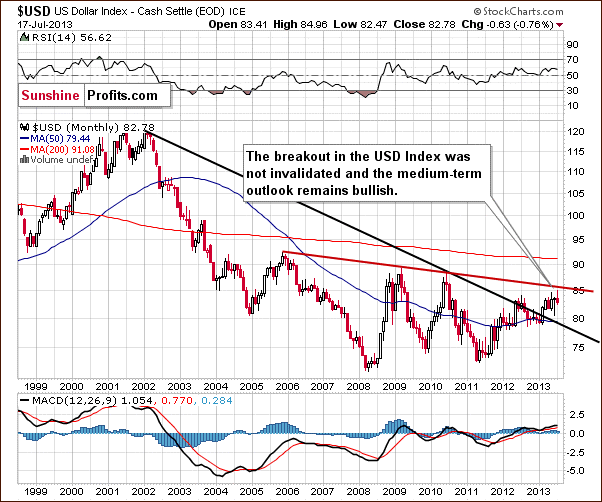
The situation in the long-term chart hasn’t changed recently. The breakout above the declining support/resistance line (currently close to 79) has not been invalidated. Therefore, the situation remains bullish.
Now, let’s zoom in on our picture of the USD Index and see the medium-term chart.
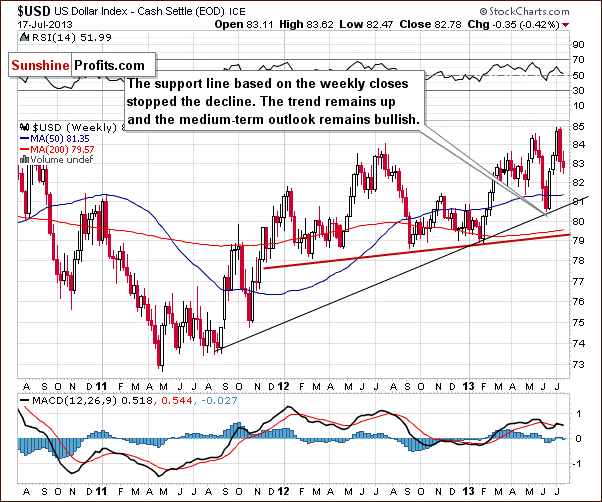
On the weekly USD Index chart we see that the recent declines didn’t take the index below 82, so the medium-term uptrend is not threatened. The reason is that the medium-term support line was not broken – it was not even reached. From this perspective, the situation remains bullish and we can expect the dollar to strengthen further in the coming weeks.
Let’s check if the short-time outlook is also bullish.
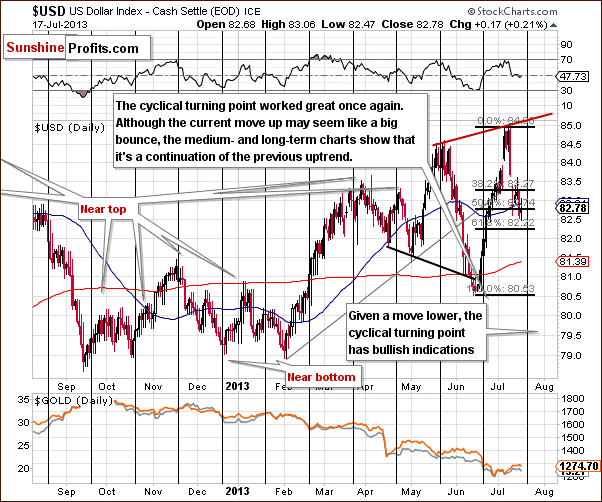
From the short-term perspective, we see that the USD Index dropped last week, but it hasn’t declined below the 61.8% Fibonacci retracement level based on the June – July rally. Despite the dollar increased after Ben Bernanke’s testimony, the U.S. currencyslipped against other currencies once again in the recent days. Although the dollar declined below the Wednesday’s intra-day low at 82.47 today, the 61.8% Fibonacci retracement level close to 82.20 is still valid and serves as support.
If the buyers manage to push the USD Index higher, we might see an increase to the June top or even to the rising resistance line based on the May high and June peak before another pause is seen. However, taking a look at the long-term charts, we see that the next significant resistance is currently close to 86 (86.4) – the declining red line.
Consequently, from the short-term perspective, the recent decline still seems to be a counter-trend bounce. It means that we could see another rally soon, especially when we factor in the cyclical turning point which is just around the corner. Taking a look at medium- and long-term charts, both outlooks for the dollar remain bullish. This is a bearish piece of information for metals and miners.
Once we know the current situation in the U.S currency, let’s find out what happened during the last several days and check the current situation in stocks. At the beginning, let’s take a look at the long-term S&P 500 chart.
Click HERE or on Chart for Larger Image
In the recent days, stocks moved up once again and broke above the May top. At this moment, the breakout is still not invalidated, but from this perspective, we see that the recent decline was likely nothing more than another correction and the outlook continues to be bullish.
We would prefer to see 2 more weekly closes before saying that another upswing is very probable. It is likely at this time but not to any great extent.
Let’s check if the short-time outlook is also bullish
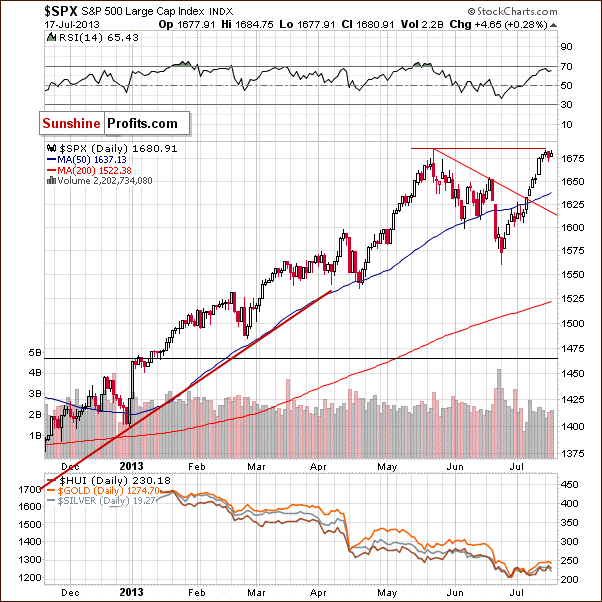
During the past week, the S&P 500 Index has continued its rally as expected. Prices climbed up to new historical highs on Thursday. The S&P500 index gained 0.5%, afterreaching a daily high at 1,693.12. The breakout above the May 22 local top is a positive sign, but some short-term uncertainty cannot be excluded here.
Let us move on to the financial sector, which often leads the general stock market, for more clues regarding the future moves of the S&P500 – we’ll use the Broker-Dealer Index as a proxy here.
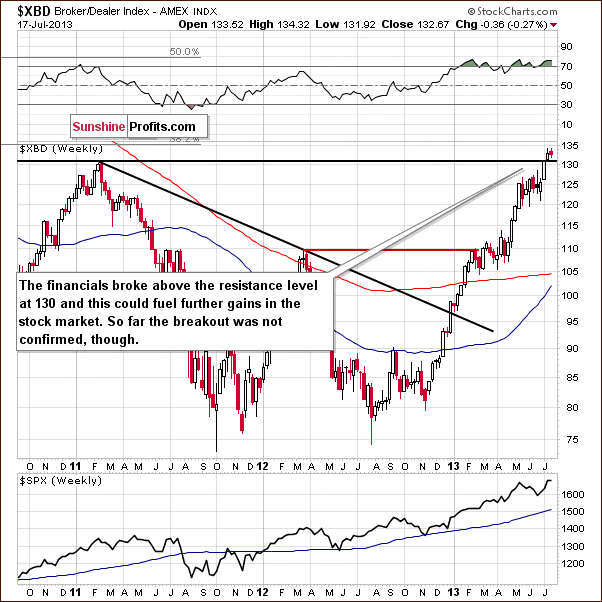
As we wrote in our essay on gold, stocks and the dollar on July 12,2013:
(…) financials broke above the resistance level at 130. This could fuel further gains in the stock market.
On the above Broker-Dealer index chart, we see that last week‘s breakout is still not invalidated. The situation improved a bit (it’s closer to being verified), and the outlook is a bit more bullish.
The situation for stocks in the medium term is still quite bullish although it’s a bit uncertain in the short term. It seems that we could see further gains in the stock market, but then again, a consolidation could be seen first. It might seem that gold started to trade along with the stock market and the bullish implications are already resulting in higher prices of the yellow metal.
Once we know the current situation in the dollar, the stock market and the financial sector, let’s take a look at the Correlation Matrix. This is a tool, which we have developed to analyze the impact of the currency markets and the general stock market upon the precious metals sector (namely: gold correlations and silver correlations).
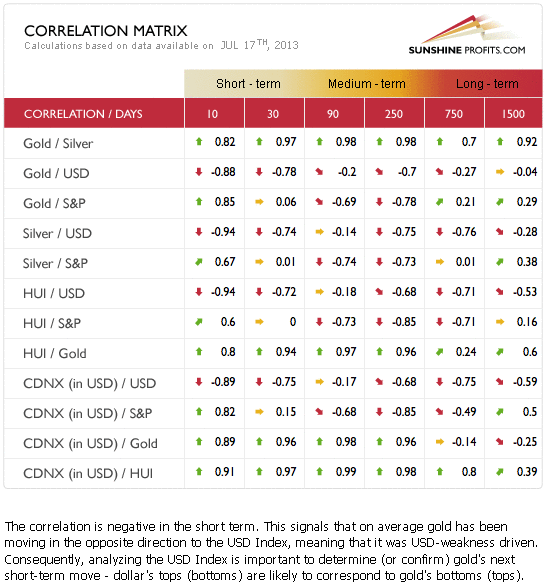
The short-term correlation between the metals and the USD Index is negative at this time and has been very weak recently. Gold started to respond to the dollar’s price moves (up when the dollar declined and down when the dollar rose) but we feel that was just a temporary phenomenon and the metals will likely continue underperforming.
All-in-all, with a bullish outlook for the dollar and regardless of whether the negative correlations between the metals and the dollar persist or not, the overall implications for the precious metals are bearish.
Summing up, the USD Index corrected almost to the final 61.8% Fibonacci retracement level but didn’t decline below it. If the buyers manage to push the USD Index higher, we might see another rally soon. This is in tune with the medium and long-term trends and also with dollar’s cyclical turning point. The implications are bearish for the precious metals sector.
Thank you for reading. Have a great and profitable week!
Przemyslaw Radomski, CFA
Founder, Editor-in-chief
Gold Investment & Gold Trading Website – SunshineProfits.com
* * * * *
Disclaimer
All essays, research and information found above represent analyses and opinions of Przemyslaw Radomski, CFA and Sunshine Profits’ associates only. As such, it may prove wrong and be a subject to change without notice. Opinions and analyses were based on data available to authors of respective essays at the time of writing. Although the information provided above is based on careful research and sources that are believed to be accurate, Przemyslaw Radomski, CFA and his associates do not guarantee the accuracy or thoroughness of the data or information reported. The opinions published above are neither an offer nor a recommendation to purchase or sell any securities. Mr. Radomski is not a Registered Securities Advisor. By reading Przemyslaw Radomski’s, CFA reports you fully agree that he will not be held responsible or liable for any decisions you make regarding any information provided in these reports. Investing, trading and speculation in any financial markets may involve high risk of loss. Przemyslaw Radomski, CFA, Sunshine Profits’ employees and affiliates as well as members of their families may have a short or long position in any securities, including those mentioned in any of the reports or essays, and may make additional purchases and/or sales of those securities without notice.






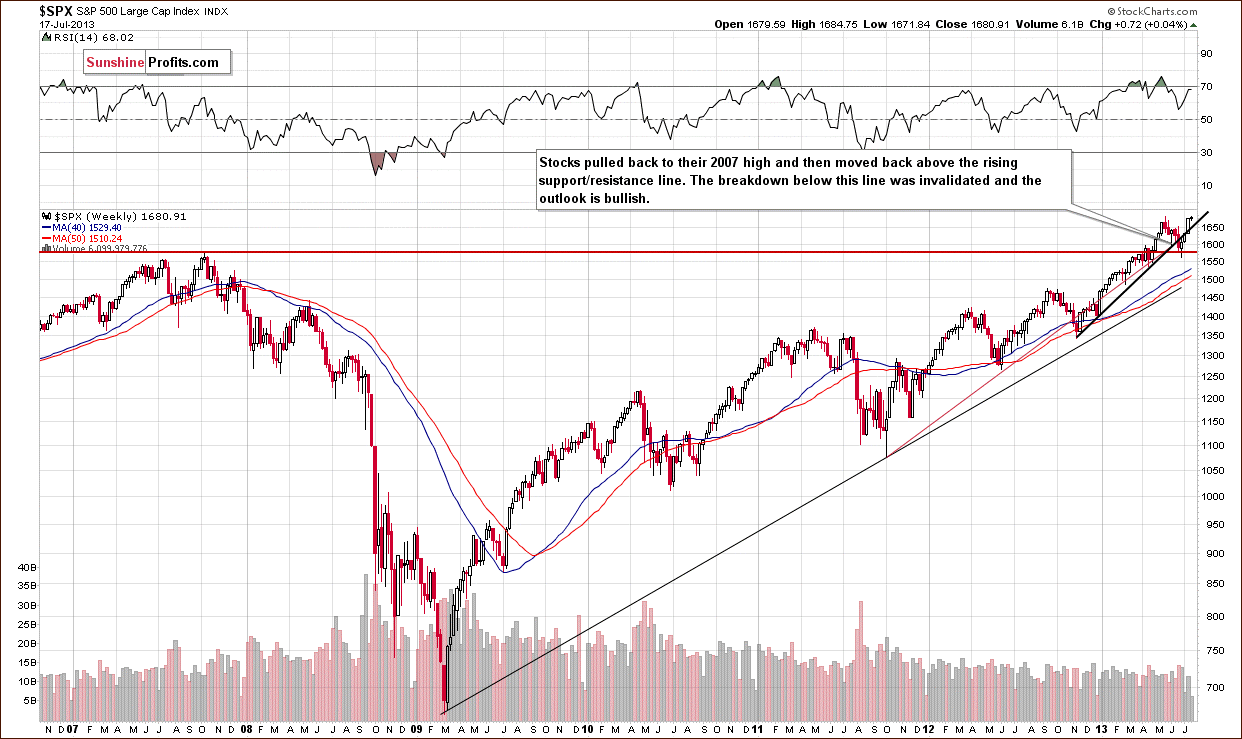











Thank you! FINALLY, this is a video that I want to share. It addresses the main issues very clearly and yet doesn’t confuse those who are new to the subject.